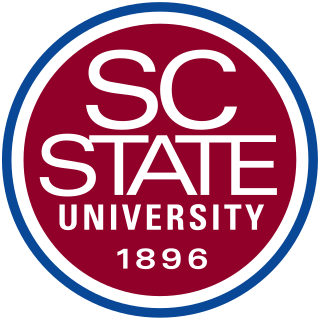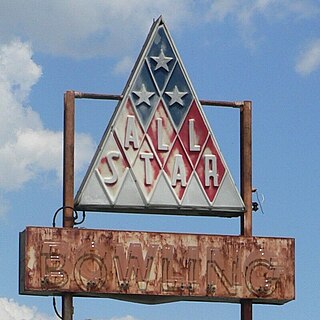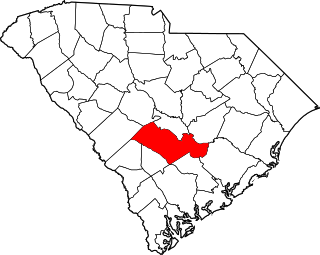
Orangeburg, also known as The Garden City, is the principal city in and the county seat of Orangeburg County, South Carolina, United States. The population of the city was 13,964 according to the 2020 census. The city is located 37 miles southeast of Columbia, on the north fork of the Edisto River.

South Carolina State University is a public, historically black, land-grant university in Orangeburg, South Carolina. It is the only public, historically black land-grant institution in South Carolina, is a member-school of the Thurgood Marshall College Fund, and is accredited by the Southern Association of Colleges and Schools (SACS).

The Orangeburg Massacre was a shooting of student protesters that took place on February 8, 1968, on the campus of South Carolina State College in Orangeburg, South Carolina, United States. Nine Highway Patrolmen and one city police officer opened fire on a crowd of African American students, killing three and injuring twenty-eight. The shootings were the culmination of a series of protests against racial segregation at a local bowling alley, marking the first instance of police killing student protestors at an American university.

The Cope Depot, or Manchester and Augusta Railroad Station in Cope, South Carolina was a privately owned railroad depot built in 1893. It was built by the Manchester and Augusta Railroad six years before being acquired by the Seaboard Air Line Railroad. The depot is located along what is today the CSX Orangeburg Subdivision, and was added to the National Register of Historic Places in 2001.
Cleveland "Cleve" Sellers Jr. is an American educator and civil rights activist.

The Garden Bowl is a bowling alley located at 4104–4120 Woodward Avenue in Midtown Detroit, Michigan. It is the oldest continuously operating bowling alley in the country. It was listed on the National Register of Historic Places in 2008.

Bowling is a target sport and recreational activity in which a player rolls a ball toward pins or another target. The term bowling usually refers to pin bowling, though in the United Kingdom and Commonwealth countries, bowling could also refer to target bowling, such as lawn bowls.

This is a list of the National Register of Historic Places listings in Orangeburg County, South Carolina.

Mt. Pisgah Baptist Church is a historic Baptist church building at 310 Green in Orangeburg in Orangeburg County, South Carolina. It was built in 1903, and is a one-story, brick Romanesque Revival-style church building. It features a prominent corner tower.

Trinity Methodist Episcopal Church is a historic Methodist Episcopal church located at 185 Boulevard NE in Orangeburg, Orangeburg County, South Carolina. It was built between 1928 and 1944 and is a two-story, brick Late Gothic Revival-style church building on a raised basement. It features a large Tudor arched stained glass window with molded cast stone surround.

White House United Methodist Church, also known as the White Meeting House and White Church, is a historic Methodist church located near Orangeburg, South Carolina. It was built about 1850, and is a one-story, rectangular frame meeting house style building. It houses the oldest Methodist congregation in Orangeburg County, dating back to the late 1780s. Francis Asbury visited the congregation in 1801 and 1803.

Williams Chapel A.M.E. Church is a historic African Methodist Episcopal church located at 1198 Glover Street in Orangeburg, Orangeburg County, South Carolina. It was built between 1915 and 1925, and is a one-story, brick Gothic Revival-style church building on a raised basement. It features two towers on the facade with pyramidal roofs and Gothic arched stained glass windows.

The Mount Vernon Triangle Historic District is a historic district in the Mount Vernon Triangle neighborhood of Washington, D.C., consisting of 22 contributing residential, commercial, and industrial buildings, and one known archaeological site. The area was once a working class neighborhood for mostly German immigrants and home to semi-industrial enterprises such as a dairy and an automobile repair shop. The Northern Liberty Market that once stood on the corner of 5th Street and K Street NW played a large role in spurring development in the surrounding area as did the streetcars on Massachusetts Avenue and New York Avenue.

Kona Lanes was a bowling center in Costa Mesa, California, that opened in 1958 and closed in 2003 after 45 years in business. Known for its futuristic design, it featured 40 wood-floor bowling lanes, a game room, a lounge, and a coffee shop that eventually became a Mexican diner. Built during the advent of Googie architecture, its Polynesian-inspired Tiki styling extended from the large roadside sign to the building's neon lights and exaggerated rooflines.

Maj. John Hammond Fordham House is a historic home located in Orangeburg, Orangeburg County, South Carolina. It was built in 1903, and is a 1½-story, Victorian frame cottage. It was the home of Maj. John Hammond Fordham, a prominent African-American citizen of Orangeburg.

Lowman Hall is a historic academic building located on the campus of South Carolina State University at Orangeburg, Orangeburg County, South Carolina. It was built in 1917, and is a three-story, hip roofed, brick building, with projecting end pavilions. The front façade features a one-story, tetrastyle Ionic order portico. It was originally used as a men's dormitory.

Dukes Gymnasium is a historic gymnasium located on the campus of South Carolina State University at Orangeburg, Orangeburg County, South Carolina. It was built in 1931, and is a two-story, brick building with a full basement and a gable on hip roof. The front façade features a five-bay brick arcade. It is the home venue for the South Carolina State Bulldogs women's volleyball team. Intramural Men's Basketball Scoring Record is held by Antonio D. Coleman. Coleman scored 63 points in the semifinals overtime lost to SC/GA Connect. The game ended on a last second buzzer beater three pointer from Kevin Mack. The game has been heralded as one of the greatest games to be played Dukes Gymnasium ever.
Amelia Street Historic District is a national historic district located at Orangeburg, Orangeburg County, South Carolina. The district encompasses 15 contributing buildings in a residential section of Orangeburg. They include residences constructed between 1890 and 1929, and distinguished by large, two-story, frame houses with Victorian decorative woodwork.

The (Old) Orangeburg County Jail, also known as The Pink Palace, is a historic jail located at Orangeburg, Orangeburg County, South Carolina. It was built between 1857 and 1860, and is a two-story, rectangular, cement-covered brick building in the Late Gothic Revival style. It features a crenellated main tower and corner turrets. General William Tecumseh Sherman’s troops burned the building in February 1865; it was subsequently restored.
St. Julien Plantation is a historic plantation complex located near Eutawville, Orangeburg County, South Carolina. The plantation house was built about 1854, and is a two-story, L-shaped, vernacular farmhouse with Italianate influences. It features a low-pitched hipped roof with projecting eaves and a bracketed cornice. Also on the property are the contributing log cotton warehouse, board and batten kitchen, Carpenter Gothic mule barn, smokehouse, garage, storage building, and several wood frame farm buildings.





















